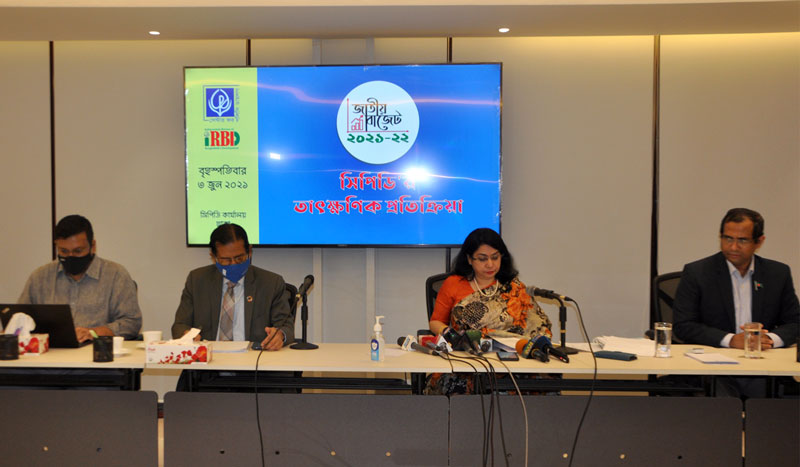
The National Budget of FY2021-22 is the 50th budget of Bangladesh. This is the second budget amidst the COVID-19 pandemic. This budget was presented at a time when impacts of COVID are still being felt. The implementation of the FY2020-21 was also faced with challenges from the pandemic. In this backdrop, the followings are vital for FY2021-22: i) tackling health risks by mass vaccination and improvement of the health sector; ii) ensuring expansion of the social safety net; iii) employment generation by increasing public investment; and iv) recovery of the economy through an effective medium term plan.
The macroeconomic performance of FY2020-21 has reflected many weaknesses, such as deficit in revenue collection; weakness in public expenditure; slow pace of project implementation; declining rate of implementation of the annual development plan; decrease in production of enterprises, especially small enterprises; and upward trend in food inflation.
On the other hand, some positive sides were also observed. For example, exports and imports are gaining momentum; high remittance inflow; comfortable balance of payments; stable exchange rate issues and an increase in foreign exchange reserves.
In this backdrop, many issues were not addressed in the budget. Special needs in view of the COVID-19 pandemic were not taken into consideration.
These views were shared as the immediate reactions of the Centre for Policy Dialogue (CPD) to the National Budget FY2021-22. CPD’s Executive Director, Dr Fahmida Khatun upheld these views on behalf of the Centre, immediately after the Hon’ble Finance Minister proposed the budget at the National Parliament.
The GDP growth target for the next fiscal year has been at 7.2 per cent, expecting a regular flow of growth. A lot of investment is required in the next fiscal year to achieve this growth. It is unclear from where this investment will come if public and private investment do not increase.
The revenue collection targets have been set similar to the last fiscal year. This is also unclear on how this target will be achieved. It will not be possible to achieve this targets given current situation. The revenue mobilisation should focus on giving advantages to business organisations instead of individuals. The exemptions in VAT and Tax will help the businesses to revive. Also, the low interest loans for the small and medium enterprises is a good move. Although, the tax-free income level was not raised for the lower-income group. Doing so would have helped people have higher disposable income and investable money. Since, increasing the consumption capacity and public expenditure should be the prime focus.
A major amount of the allocated money for public expenditure has been allotted for public administration. Under the current circumstances, development expenditures need to increase and non-development and operating costs need to be decreased. Savings from this can be used for investment that generates employment.
The expenditure under the annual development programme is lower than earlier years. This strongly reflects the inability to implement. The government will rely on foreign loans to finance the budget deficit. Although, the government needs to keep a check that the loans do not add extra burden. We are still in a state of ease in terms of loan repayment and this needs to be maintained.
In case of sectoral priority, health sector stands above all. As proportion of the total budget the allocation for FY2022 increased to 5.42 per cent from that of 5.15 per cent for FY2021. Although, this is lower than FY2010 allocation for health sector of 6.18 per cent, when there was no pandemic. The main focus should of the health sector should be on vaccination. We are unaware for how long the COVID pandemic might have its impacts. Economy will not get back to its previous flow if we do not recover from COVID-19. Therefore, all eligible people should vaccinated. There is an allocation of Tk. 10,000/- crore for vaccination, but this is insufficient. The allocation for health sector is similar to last year and the previous year to that. The health sector allocation was 0.95 per cent of the GDP in the last FY2020-21, this is still the same for this year. Thus, the allocation in health sector is not increasing at a time when we need the health sector allocation the most. Allocation is required for vaccination programme, hospital beds, ICU, oxygen and etc. The question remains, will it be implemented even if there were sufficient allocations. Therefore, increasing allocation will not help either. Hence, the Centre suggests to have sufficient allocation for the health sector and simultaneously, medium-term actions reforms should be made to ensure efficient use of the allocations. It is time to re-design the full health sector. No such initiatives were seen in the last one year.
The Centre also feels the need to prioritise the social security sector. Allocations have increased in this sector. Although, this allocation still has pensions of government officials included. Thus, this allocation is not as big as it seems.
In short, a budget to fight the pandemic situation and rejuvenate the economy is not seen. This budget should have had a clear guidance of how the health sector, education, social security, employment, how will the expenditure pattern of other sectors be and ways of revenue mobilisation. Overall, weak assumptions and limitations in implementation may pose challenge in implementation of COVID budget.
Professor Mustafizur Rahman, Distinguished Fellow; Dr Khondaker Golam Moazzem, Research Director and Mr Towfiqul Islam Khan, Senior Research Fellow were also present at the event.



